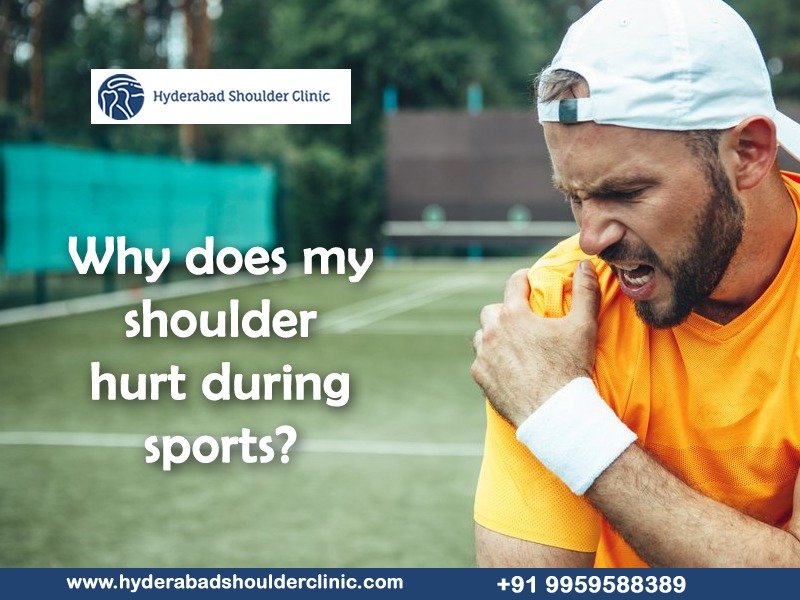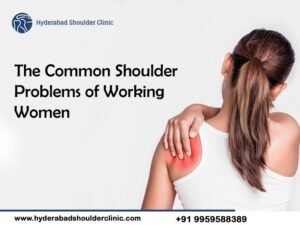Out of all the numerous joints in the body, the shoulder is the most flexible joint in the body. It allows us to do various activities and rotates in various directions. It can bear heavy loads, do repetitive actions, and perform daily chores. Due to the anatomical structure of the shoulder joint, all these activities are possible. Due to this flexibility, the joint is also slippery and prone to various injuries. Especially for those who play sports, the shoulder is a key joint that requires special care.
Broadly shoulder injuries can be acute (sudden onset) or chronic (gradual onset). The main reasons for shoulder injuries for sports professionals are overuse, falls, repetitive motion, and injuries.
Why does my shoulder hurt during sports?

Rotator cuff strain
The rotator cuff is the name given to the muscles and tendons around the shoulder joint. The rotator cuff keeps the head of the upper arm bone firmly within the shoulder’s shallow socket. The strain on the rotator cuff is a common cause of acute shoulder pain in sports. It is common for those professionals to play throwing and racket sports. The tear can happen in any of the shoulder’s four ‘rotator cuff’ muscles. The sportsperson experiences the below symptoms:
- Recurrent pain, especially with certain activities.
- Pain that prevents you from sleeping on your injured side.
- They might hear cracking sounds when moving your arm.
- Limited ability to move your arm.
- Muscle weakness.
Acromioclavicular joint sprain
An AC joint connects the acromion and clavicular bones at the top of the shoulder. A tear or separation can sprain the AC joint. AC joint injuries occur due to falling onto an outstretched arm. They could be between a mild to a complete tear of the ligament. As soon as the AC joint tear occurs, the sportsperson will feel severe pain which may radiate throughout the shoulder.
Slowly the pain localizes to the bony bit on the top of your shoulder.
Shoulder dislocation

Due to overuse, repetitive motions, or a traumatic fall, the sportsperson may dislocate their shoulder. A dislocated shoulder is traumatic and painful, where the head of the humerus (upper arm bone) pops out of the shoulder joint. As soon as the shoulder dislocation occurs, below things happen:
- Sudden shooting pain at the time of injury.
- The shoulder joint rapidly swells up.
- The arrested motion of the arm.
Popping the shoulder joint back to its place requires a lot of practice and is best done by a professional. If you attempt alone, you might damage the surrounding tendons, ligaments, nerves, and blood vessels. Early medical intervention combined with physical therapy is the key to healing shoulder dislocation.
Rupture of the long head of the bicep
A common shoulder injury in older athletes is a tear or strain of the long tendon of the biceps muscle that originates from the shoulder. The athlete will feel:
- Sudden shooting pain in the front of the upper arm/shoulder.
- Swelling over the front of the shoulder joint.
Any attempt to contract the biceps against resistance will be painful.
Lifting the arm straight up against resistance leads to pain and increases swelling.
Clavicle fracture – Broken collarbone
A traumatic fall, especially on the arm, can break the collarbone. Pain is accompanied by swelling, and it requires medical attention immediately.
Pectoralis major tendon strain

A strain or tear of the powerful pectoralis major muscle at the front of the chest. The pectoralis major is a muscle that helps to rotate the arm inwards. The point where this muscle attaches to the humerus (arm) bone is a weak point. This tear can happen when there are rapid inward arm rotations. One experiences pain and swelling at the front of the shoulder.
Tendonitis – Rotator cuff tendinopathy
In this degenerative condition, one or more of the rotator cuff tendons in the shoulder are affected. The patient experiences pain while resting and worsens while lifting things, especially above the shoulder. Shoulder tendons feel tender, and the shoulder may creak when the shoulder moves.
Shoulder impingement pain arc
Commonly known as a swimmer’s or thrower’s shoulder, it happens when the rotator cuff muscles’ tendons become trapped or impinged. The pain gradually increases over days or weeks. Pain is felt in the front and/or outside your shoulder joint. For those playing throwing or racket sports, the symptoms are worse during overhead movements.
Frozen shoulder
A frozen shoulder is commonly seen in older athletes, which causes pain and restricted movement in the shoulder joint. The patient experiences 3 stages of pain.
Shoulder ache, with the pain becoming more widespread and worse at night.
The joint stiffens, and the pain may limit daily activities.
In the third stage, the shoulder will begin to loosen up with treatment, and the pain will ease.
Glenoid labrum tear
Glenoid labrum tear is more common in sports that involve repetitive movements such as overhead throwing. The tear happens when the tissue lining the shoulder joint socket tears. There is weakness and pain in your shoulder joint. Elbow bending or moving the arm behind your back may reproduce symptoms.
Subacromial bursitis
The bursa is a small sack of fluid between the tendon and bone, and it can become impinged or trapped in the shoulder. The athlete will have difficulty when lifting sideways through a 60-degree arc.
How can sports enthusiasts prevent shoulder problems?
- Maintain good posture
- Get stronger
- Pay attention to body mechanics
- Stretches
- Rest and rehab
Our highly experienced shoulder surgeon Dr.Chandra Shekhar has worked with many athletes on maintaining healthy shoulders. He has cured shoulder issues for many athletes. Please visit our website https://hyderabadshoulderclinic.com/ or contact us at +91 9959588389, shoulderandsportsclinic@gmail.com





